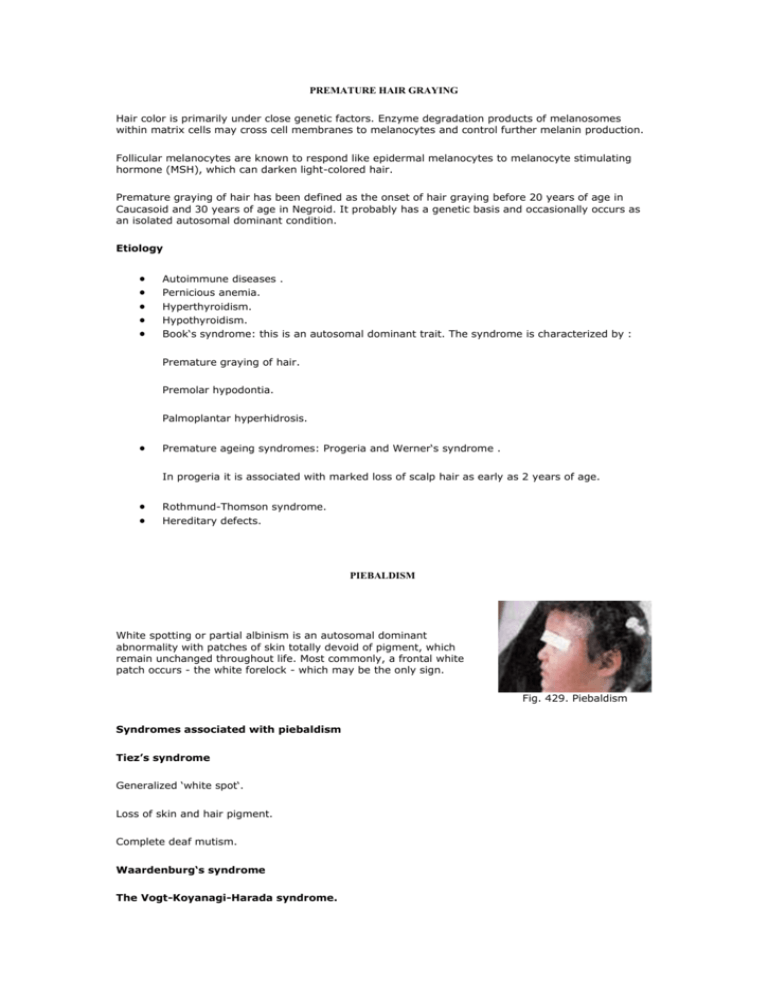PREMATURE HAIR GRAYING
advertisement

PREMATURE HAIR GRAYING Hair color is primarily under close genetic factors. Enzyme degradation products of melanosomes within matrix cells may cross cell membranes to melanocytes and control further melanin production. Follicular melanocytes are known to respond like epidermal melanocytes to melanocyte stimulating hormone (MSH), which can darken light-colored hair. Premature graying of hair has been defined as the onset of hair graying before 20 years of age in Caucasoid and 30 years of age in Negroid. It probably has a genetic basis and occasionally occurs as an isolated autosomal dominant condition. Etiology Autoimmune diseases . Pernicious anemia. Hyperthyroidism. Hypothyroidism. Book‘s syndrome: this is an autosomal dominant trait. The syndrome is characterized by : Premature graying of hair. Premolar hypodontia. Palmoplantar hyperhidrosis. Premature ageing syndromes: Progeria and Werner‘s syndrome . In progeria it is associated with marked loss of scalp hair as early as 2 years of age. Rothmund-Thomson syndrome. Hereditary defects. PIEBALDISM White spotting or partial albinism is an autosomal dominant abnormality with patches of skin totally devoid of pigment, which remain unchanged throughout life. Most commonly, a frontal white patch occurs - the white forelock - which may be the only sign. Fig. 429. Piebaldism Syndromes associated with piebaldism Tiez’s syndrome Generalized ‘white spot‘. Loss of skin and hair pigment. Complete deaf mutism. Waardenburg‘s syndrome The Vogt-Koyanagi-Harada syndrome. This syndrome is characterized by: Alopecia areata. Bilateral uveitis. Labyrinthine deafness. Tinitus, vitiligo and poliosis Alezzandrini‘s syndrome Unilateral facial vitiligo. Retinitis. Poliosis of eyebrows and eyelashes . Perceptive deafness is rarely associated. Tuberose sclerosis Depigmented hair may be the earliest sign . Von Recklinghausen‘s disease Multiple neuro fibromatosis: café au lait macules, axillary, perineal freckling, and cystic lesions. Nutritional deficiencies In protein malnutrition, such as in kwashiorkor, hair color changes which are prominent features. Normal black hair becomes brown or reddish, and brown hair becomes blonde. Severe iron-deficiency anemia. White hair may occur in vitamin B12 deficiency. Metabolic disorders Severe ulcerative colitis and after extensive bowel resection. Phenylketonuria :Black hair may become brown., Homocystinuria. Accidental hair discoloration Exposure to high concentrates of copper in industry or from inadvertently high concentrations in tap water or in swimming pools may cause green hair, particularly visible in blonde-haired subjects. Picric acid and Dithranol may cause yellowish hair. Hair cosmetics Soaps and shampoos are made from vegetable or animal fats that can remove dirt and greases as efficiently as detergents . The ingredients contained in the shampoos such as tar and many others may cause change of the hair color. Straightening gels and fixatives of the hair may have also the same effect.








